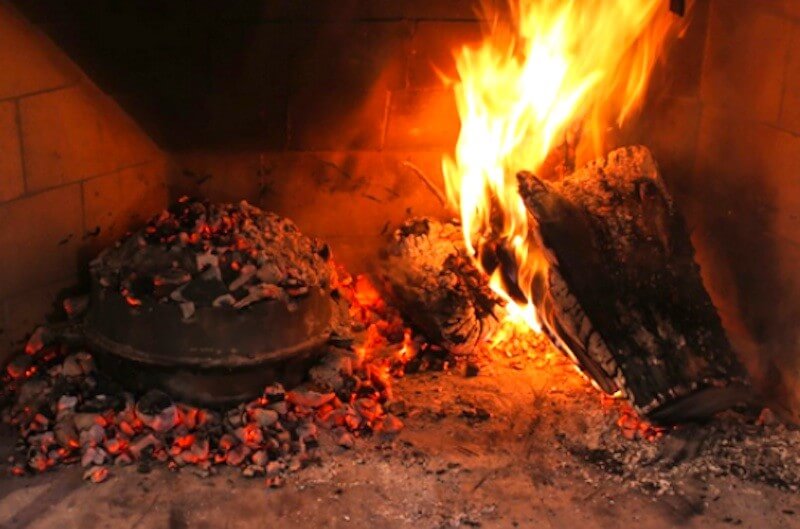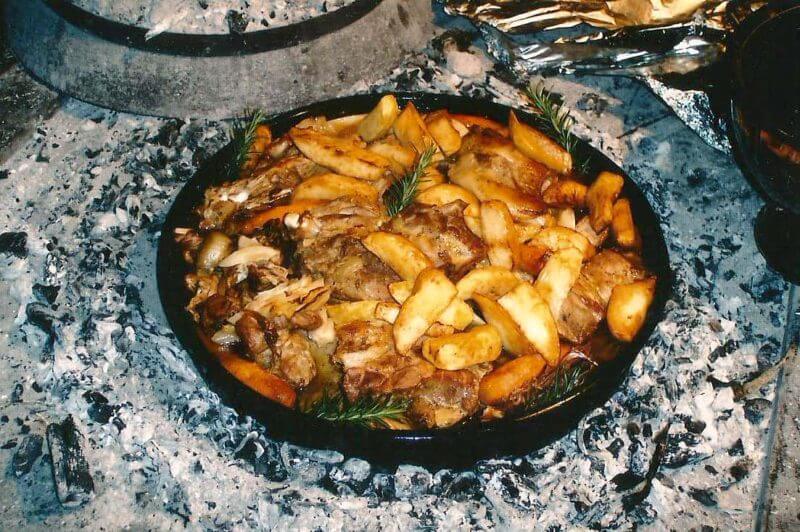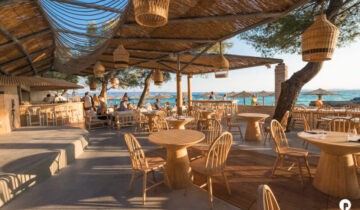In this article we bring you some of the “secrets” of traditional Croatian cuisine and there would be no sense to talk about the specifics of our gourmet without mentioning peka!
Roasted veal and lamb under the bell are delicious delicacies we all enjoy, although, we love octopus prepared in the same way just as much. The important thing is that the meat is fresh and the friends are together.
Baking dishes over an open fire, in addition to the food having a specific aroma, is related to the ancient notion of the fireplace being the heart, the center of each house, where the family gathers, talks, socializes and where they prepare meals.
With the arrival of spring, gathering around the fire in the open is certainly a more common way of spending leisure time and having fun. We mostly gather around the grill, but if you have the opportunity to prepare meals under the bell, do it, because dishes baked under the bell are the ultimate delicacy of Croatian cuisine.
What is baked under the bell?
Baking dishes under the lid, the bell, honeycomb, depending in which part of the country you are in, is the traditional way of preparing food in this area, and the food is actually half-baked, half-cooked in its own juices. The aroma and smell of dishes prepared this way are really special.
Enjoying delicious veal, lamb or goat meat under the bell or seafood specialties such as octopus and rays is best with warm homemade bread.
Lamb is often prepared this way in the spring, with new potatoes, and all of this is enjoyed with wine and local brandy as an aperitif. In principle, you can prepare any type of meat this way; some prepare even stews and soups, claiming that they are actually delicious. We can say that each of them is right, because tastes should not be discussed, especially when it comes to the centuries-old tradition of Croatian cuisine and local gastronomy.
Dishes baked this way have always been prepared in the Dalmatian hinterlands, and even today on the weekends families and friends gather around the traditional bakers to enjoy specialties from old times. Due to concentrated aromas during the cooking under the bell, the result is juicy and delicious meat. If you add vegetables, the flavor is even stronger.
How does peka work in the Croatian cuisine?
The best masters of Croatian cuisine, naturally of peka as well, claim that the secret of the perfect preparation is in the heat obtained from high-calorie wood, such as beech or hornbeam. This wood retains optimal temperature for a long time that is required for the baking.
This is achieved by making a fire on a larger, flat fireclay panel of a grill or an oven. Fireclay is able to hold the heat longer and is resistant to high temperatures. It is a good idea to start a fire up to an hour and a half before laying the peka over it. When the barbecue is set, you can start the baking process.
The bottom of the baking dish placed on the grill (usually a large round container) is covered with a little oil or fat, and on top of it is the meat cut into large pieces (or in one piece) that we previously dried and rubbed with salt and spices, around which we put potatoes and other vegetables. If desired, you can add some wine as well.
The most commonly used meat are leg, shoulder, ribs, or knuckle. Food is covered with the upper portion of peka (the bell), which is usually made of cast iron and clay, so that the grill can envelop the dish and cook the food from all sides. The bell has an edge that keeps the grill. Open flame should not be allowed, but only a slight grill and warm ashes, otherwise the food might burn on the outside and remain insufficiently cooked in the middle.
The longer baked, the meat is softer
It is a good idea to maintain the reserve of the barbecue grill on the side panel to put it on the peka later, when the originally placed has depleted.
If baking meat such as lamb, veal or pork, give it plenty of time, depending on the size of the pieces. During the cooking this way, concentrated juices under the lid are gradually reduced, so it is good to keep peka under the grill at least 2 to 2.5 hours.
For the ultimate experience it is of the most importance that the meat is of good quality and fresh. During baking it is necessary to occasionally open peka (it is quite difficult to achieve this, so use a lever) and check the condition, flip the meat and stir the vegetables and if necessary add a little more wine.
If you purchased a new peka, it should be slightly warm before the first use (both the lower bowl and the bell) and greased with cooking oil or fat. It is recommended to rinse peka with water and not wash it with detergent to prevent rusting, but to use a well-brushed iron brush inside and out and wipe it with a dry cloth or a towel and then coat the insides with grease or oil again.
So, how to prepare meat in peka to truly experience the traditional Croatian cuisine experience?
1. The meat is cut into pieces and rubbed with salt. Make a marinade of oil and spices that suits you. In the traditional Croatian cuisine we use Dalmatian herbs, a little pepper, a teaspoon of red pepper and garlic granules. Leave the meat overnight in a marinade.
2. Peel the potatoes, cut them into quarters and spread over the pan. Season it to your taste. Cut vegetables (mushrooms can remain whole) and add them to the spread. Meat should be placed between vegetables and all together basted with oil. Do not use too much oil because the vegetables and meat will release juices during cooking.
3. In the meantime, your friend has prepared the barbecue grill, so put the baking dish in it and cover the lid / broiler.
It is important to continue to maintain a fire in another place that could, if necessary, supply additional barbecue grill.
4. In the beginning most of the grill should flock around the lid, and only towards the end should peka be covered with it, so the meat would not be burnt on the outside and remain raw inside. After about half an hour, check what the situation is. If necessary, turn the meat. After one hour put the barbecue grill on the top of peka because it is time the ingredients enter the final roasting phase. Bake it for a while.
5. Speaking from the experience it is best to occasionally check the status of baking. Cooking time varies depending on the size and type of peka, as well as on the type of furnace.
We believe we gave you a detailed, mouth-watering description on how to bake dishes under the lid in your homes. However, if you do not own a peka, do not worry, Croatian restaurants awaits you!





 No products in the cart.
No products in the cart.